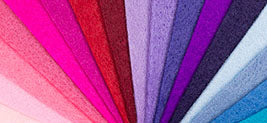Frequently Asked Questions About Felt - Part 1
Here at The Felt Store, we've noticed there are a lot of questions that customers frequently ask us and we thought it would be a great idea to share it with everyone just in case you may have similar questions. Here we have a two part F.A.Q. list that we will always add to in the future so stay posted for more info!
What are common uses of Felt?
One of the beautiful things about this ancient material is the multiple uses and functions that it has. Felt is constantly being re-invented within a wide range of disciplines.
|
|
Designer Uses:
|
|
|
Craft Uses:
|
|
Felt Wick |
Industrial Uses:
|
|
|
Other Uses:
|
How is Felt made?
There are two major felt making methods:
- The Wet Felt method is the old classic way whereby natural fibers like wool are interlocked and matted together through a process of felting and fulling (milling) by exposing the wool to heat, motion pressure and moisture in the form of hot steam and water. In that process the natural scale structure of the wool fibers open up and allow for fiber entanglement. Such interlocking and shrinkage is continued until a desired density is achieved.
- The Needle Felt method in contrast is a dry process (no water and steam) that does not require natural fibers like wool in order to interlock. The interlocking of fibers is achieved through a mechanical up and downward motion of metal needles with barbs that transport and push the fibers together into a matted form.
Watch our How Felt is Made video for a better understanding of how felt is made.
What is Felt made of?
Felt can be made of many different fibers or one specific fiber. The main component of high quality Felt is wool, this may be 100% wool or a blend of wool and a variety of other materials depending on its quality and required use. Felt made of a blend of fibers may contain reprocessed wool (e.g. old sweaters), recyclable fibers (e.g. cotton), viscose/rayon (a wood fiber, or sometimes polyester. Felt may also be made from other synthetic fibers such as acrylic. This type of felt is typically used for arts and crafts projects.

What is the difference between the Industrial Felts?
Industrial Felts are usually not dyed and retain their natural colors, ranging from a light beige to dark browns and grays. Because industrial felts are made of natural wool there are times when color variations or blemishes in the felt may occur. For example, the white is often not a pure white, but an off white, which may have some blemishes. The gray industrial felt at times may vary from gray, to grayish brown, to having a blue tint, etc. It all depends on the batch being created. This variation cannot be guaranteed in the production process as it is dependent on the natural bails of wool to create the felt. This may vary greatly from roll to roll.
White wool's are higher quality wool's and are more resilient than gray wool's. It is hard to specify the uses of each felt quality because the function is dependent on the required density and thickness. The following is a list of recommended uses:
F-1:
Color: White/Beige
Wool Content: 95%
Use: Is suitable for oil retention in installations where the felt is not compressed, for feeding low viscosity or light oil, and where unusual strength and hardness are required. Washers, bushings, wicks, door bumpers, polishing blocks, and parts where wear and resistance to abrasion are required, are typical uses.
F-3:
Color: Gray
Wool Content: 85%
Use: Recommended for vibration mountings and the same general purposes as SAE F-1 and where a felt of slightly lower quality is satisfactory.
F-5 & F-7
Color: F-5 White/Beige, F-7 Gray
Wool Content: F-5 95%, F-7 80%
Use: Recommended for dust shields, wipers, grease retainer washers, wicks, vibration mountings, and in uses where a resilient felt is required.
F-10
Color: White/Beige
Wool Content: 95%
Use: recommended for grease and oil retention where the felt is confined and compressed in assembly. Also recommended for dust shields under less severe operating conditions where F-5 and F-7 are not required.
F-15
Color: Gray
Wool Content: 55%
Use: Recommended for sound deadening, chassis strips, spacers, dust shields, pedal pads, dash liners, and mechanical purposes where abrasion and wear are not important factors.
F-26
Color: Gray
Wool Content: 40%
Use: Is a cheaper low density felt recommended for non-mechanical applications when retained between other materials. Other uses include padding, packaging and in some cases sound absorption.
F-50
Color: White/Beige
Wool Content: 95%
Use: The same quality as SAE F-1, bellow 1/8th thick
F-51
Color: Gray
Wool Content: 92%
Use: The same quality as SAE F-3, bellow 1/8th thick
F-55
Color: Black and Gray
Wool Content: 80%
Use: The same quality as F-7, bellow 1/8th thick
Is there color variation between Felts?
We encourage customers not to rely on screen representations of our felt colors. Different computer monitors vary in color calibration. Please contact us and we will provide you with desired samples or if you are looking our designer felt, please purchase our samples online. Further more, craft and designer felt colors rely on different qualities, therefore varying amongst each other. Dye lots amongst the craft felts may vary slightly, while Industrial (natural) felt colors change according to wool blends and mixtures.
 USA
USA CANADA
CANADA EUROPE
EUROPE
















Leave a comment